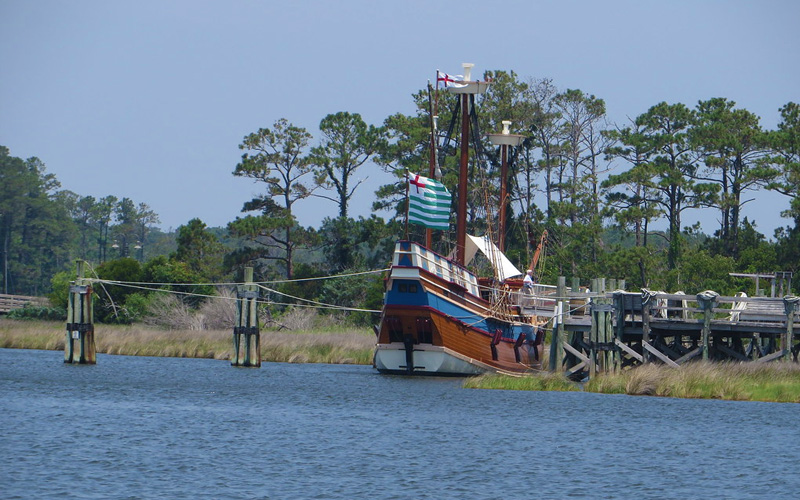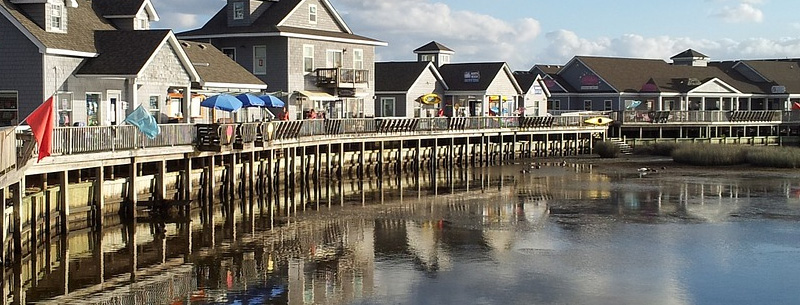The Outer Banks in North Carolina extends into the Atlantic Ocean, offering visitors plenty of sand and recreational activities. Consisting of a 100-mile long group of islands, the Outer Banks welcomed the first European settlers to this country and witnessed mankind’s first winged flight.

Serving as barrier islands, the Outer Banks are exposed to the storms of the Atlantic Ocean. Sand is pulled out and shifted, causing the islands to make a gradual westward move of approximately one to two feet every year. Indeed, many of the shipwrecks that took place several hundred years ago right offshore would be as much as a mile further out into the Atlantic Ocean today if they happened in the same spot.
The 5 Islands
The Outer Banks is a string of islands unlike any other in the United States. The fact that there are just a scant few bridges and several ferries linking the islands to the mainland only heightens their unique qualities and the lifestyle they represent.
The Outer Banks of North Carolina are made up of 5 major groups. Although there are several smaller islands south of Ocracoke, since they are so remote and not easily accessible, we’re not including them in this discussion. Also, while you can argue that Bodie is not really an island because that strip of land that crosses the Virginia border has been cut off, it has become a virtual island.
- Roanoke
- Colington
- Bodie
- Hatteras
- Ocracoke
The Outer Banks was given the name “graveyard of the Atlantic” by US Statemen Alexander Hamilton due to the mass collection of ships that were sunk and hundreds of lives that were lost as violent storms marched up the coast as they crept past the islands. The American government, in an attempt to provide navigational assistance, constructed several lighthouses along the Outer Banks shoreline. Today only four of these ancient watchtowers continue to stand although their lights have long since been extinguished.
Nearby in Kill Devil Hills, is where the two brothers from Ohio, Wilbur and Orville Wright, attempted to make the first manned flight of an aircraft in 1903. Their twelve-second voyage was short but became one of mankind’s greatest moments in history.
Other outstanding features of the Outer Banks include Jockey’s Ridge State Park featuring the tallest sand dunes on the East coast; the Cape Hatteras National Seashore with excellent beaches and one of the remaining ancient lighthouses; wildlife refuges and maritime forests for nature hikes and exploring; and a host of other recreational activities including kiteboarding, surfing, deep-sea fishing, swimming, boating, and just plain relaxing in the sun.
The Outer Banks in North Carolina has something for just about everyone and is well worth exploring. You will be amazed the first time and every time you visit. This is fun for the entire family.
Outer Banks Beaches
Of all the qualities associated with the Outer Banks are the beautiful sandy beaches and the rolling surf along the eastern side of these barrier islands. The Outer Banks is a major tourist destination, known for its mild climate and the wide expanse of open beachfront.
Thanks to information provided by the weather service, in the early 1900s, the Wright brothers selected these islands because of the sandy beaches and steady winds that made it an ideal location for testing their theories of flight.
The Outer Banks is actually a series of sandy islands stretching north and south. Because the islands are primarily sand, they are constantly in a state of fluctuation as a result of strong storms including hurricanes and Nor’easterns. It is where the warm waters of the Gulf of Mexico first meet the cold waters of the North Atlantic, making for a very unique micro-climate, and a dangerous place for shipping.

Many of the towns we so cherish today are there as a result of the dangerous waters and the many shipwrecks. It was a paradise for salvagers and a place where heroic life-saving attempts became legendary.
The beach is where the ocean meets the land. It is an ever-changing landscape that ebbs and flows with time and weather. If left solely up to Mother Nature the Outer Banks today would look entirely different, but because we have intervened and tried to stop the process, the beachfront of the Outer Banks has become a somewhat unnatural formation, not that that is bad, it’s just different.
The beach is made up mostly of quartz crystals that have been ground down into fine particles over the centuries. It is also filled with bits of shells and other debris. Whatever makes up the exact content at any one time, makes little difference to the average beach visitor. Suffice it to say, that the beaches of the Outer Banks are a great place to spend a vacation.
Outer Banks Lighthouses
Perhaps the most iconic image of the outer banks is the numerous, uniquely painted lighthouses erected in the 1800s to protect ships from the dangerous shoals. So treacherous were the seas off the coast the area became known as the Graveyard of the Atlantic. Today there is a museum in Hatteras Village dedicated to these shipwrecks.

Bodie Island Lighthouse
The present Bodie Island Lighthouse is the third to be built since funds were allocated for the first one in 1848. Because of poor construction and the ravages of the Civil War, the two lights didn’t fare very well. Construction began on the present light in 1870 and it went into service in 1872.
Cape Lookout Lighthouse
The Cape Lookout Lighthouse is a 163-foot high lighthouse located on the Southern Outer Banks of North Carolina. It flashes every 15 seconds and is visible at least 12 miles out to sea and up to 19 miles. The Cape Lookout Light is one of the very few lighthouses that operate during the day. It became fully automated in 1950. The Cape Lookout Lighthouse is the only such structure in the United States to bear the checkered daymark, intended not only for differentiation between similar light towers but also to show direction. The side points of the black diamonds point in a north-south direction, while the side points of the white diamonds point east-west.
Currituck Beach Light Station
On December 1, 1875, the Currituck Beach Light was completed, located between Cape Henry Light and Bodie Island. Unlike its fellows, Currituck Beach Light was not painted, leaving its brick facade visible. Cape Hatteras Lighthouse, which is the tallest lighthouse in the United States, had to be moved because of beach erosion was causing the tall structure to lean. It was feared that if corrective measures were not taken, the structure might topple into the surf during a strong storm. As a tribute to the keepers of the Hatteras light, a circle of stones was placed where the original tower stood. Each granite block has the name and year of the principle and assistant keepers of the lighthouse.
Cape Hatteras
Cape Hatteras is a point that protrudes the farthest to the southeast along the northeast-to-southwest line of the Atlantic coast of North America. Just off the point two major Atlantic currents meet creating turbulent waters that redistribute the sandy bottom creating shallow sandbars extending up to 14 miles offshore. These sandbars are known as the Diamond Shoals.
Two major Atlantic currents collide just off Cape Hatteras creating turbulent waters and a large expanse of shallow sandbars extending up to 14 miles (23 km) offshore. These shoals are known as Diamond Shoals. Because mariners utilize ocean currents to speed their journey, many ships venture close to Cape Hatteras when traveling along the eastern seaboard, risking the perils of sailing close to the shoals amid turbulent water and the frequent storms occurring in the area.
Fishing Outer Banks North Carolina
The Outer Banks off the NC Coast are considered by some to be the best fishing in the US. Its a sportsman’s paradise. You can go surf or pier fishing. Fish in freshwater, the ocean or a sound. Go fishing inshore or offshore. Charter a boat to the Gulf stream and really catch some big fish.
Cape Lookout is a popular place to fish. Lots of fisherman head here when the fish start running which is from September to December. Here you will find miles of secluded beaches. You will have to bring everything with you because the seashore is far away from any stores and towns. The visitors center is on Harkers Island at Shell Point. To get here you will have to take a ferry. Ferries run from Atlantic Beach, Davis, and Beaufort.
Wild Horses
The wild horses of Currituck Outer Banks have survived almost 500 years on the sandy Outer Bank shores. Each year they draw thousands of visitors to the northern beaches. Nowhere else can you see wild Mustangs walking along the beach and grazing among beach homes.
Wright Brothers National Memorial
The visitor center features full-scale reproductions of the 1903 Wright Flyer, along with a 1902 glider the Wright brothers used to advance their theories on aerodynamics and wing warping they would later use to control their powered flight.
With your paid admission you gain access to the grounds including an exhibit hall and special exhibits. This site is operated by the National Parks Service and is open year-round except for Christmas day.
Big Kill Devil Hill Monument
The 60-foot granite monument, dedicated in 1932, is perched atop the 90′ tall sand dune known as Big Kill Devil Hill. The monument commemorates the Wright brother’s achievement. It was from this hill that they conducted many of their glider tests, but the actually powered flights were done just north of the monument on flatter ground.
The massive shifting dune that has been stabilized to reduce any further shifting of the sand. Atop the tower is a marine beacon, similar to a lighthouse beacon.
